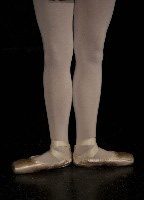Henrik teaches French (or wait a minute?!) #5 – Turnout:
In the column “Henrik teaches French“, I let you in on some technical sides of the ballet life. I’ll try to explain some steps, certain parts of the performance and hopefully even teach you some french terminology while we’re at it! Today: Turnout
 The principle of turnout is the foundation of ballet, and what separates it from other forms of dance. It is a stance in which the legs are rotated outward from the hips, making the knees and feet point in opposite directions, or to the side.
The principle of turnout is the foundation of ballet, and what separates it from other forms of dance. It is a stance in which the legs are rotated outward from the hips, making the knees and feet point in opposite directions, or to the side.
The ideal dancer has a 180° turnout. In practice, if you are standing with your legs parallel to the front, your turnout is 0 degrees. Turn both legs out 90 degrees to the side, and you have achieved a 180° turnout. This requires a very open pelvis, which not everyone posses.
The purpose of the turnout is often misunderstood to be an aesthetic ideal, but it is, in fact, rather mechanic. A person which thigh bones, or femurs, are rotated outwards in relation to the hips has a much greater ability to extend and lift the legs, especially to the side. Thus, it is a principle allowing certain movement which is not possible to do (correctly) without it, and therefore a mechanic ideal, or “trick” if you will, to achieve certain movements.
On the other hand, turnout is today the main principle of the classical ballet (together with the straight(-est possible) spine), and a classical dancer is expected to use it at all times, not only where it will help the actual movement. Therefore, one have to say that the turnout is today much as well an aesthetic tool. Dancers may be able to dance beautifully without using the turnout maximally, but a 180° turnout at all time is still expected by the most critical of the audience.
This leads to an interesting dilemma – many dancers doesn’t have a pelvis allowing maximum turnout, still this is expected. What to do?
Forcing the legs to point to the side without rotating from the hip is possible, achieved by using the (little) rotation of the other joints in your leg, the knee and the ankle. Yes, the knee can rotate, to a certain degree. THIS IS VERY DANGEROUS, and should not be done by anyone. The amount of stress the ankle- and knee-joints get by incorrectly turning out the feet is tremendous, and will lead to severe injury sooner or later. It is simply not worth it.
Does this mean you cannot dance ballet unless you are born with a “ideal” pelvis? No! There are numberless of professional dancers that do not posses the ideal dancer body. Even some of the greatest stars don’t have the opportunity to turn their legs out absolutely to 180 degrees.
Yes, you are right, there is no French words to learn this time. I just simply don’t know a French term for turnout, even if it is one of the most central ideals in ballet. Oh, well, if you do, tell me! I figured the post fits the column anyway, for it’s “technical nature”…
And yes, I know the French call it en dehors – but that’s really a direction, not a word for turning out… Just-so-you-know ![]()
‘Till next time,
Ta-ta
H


